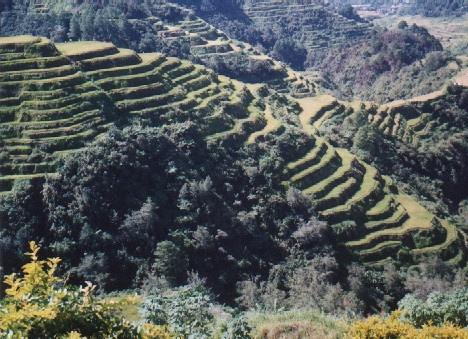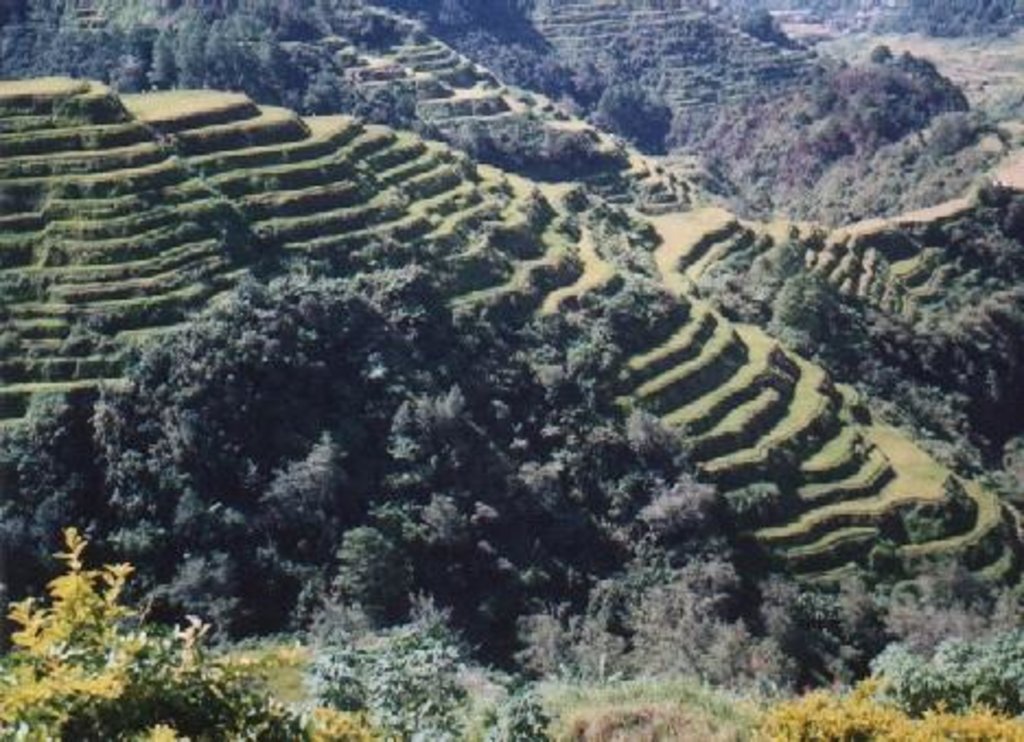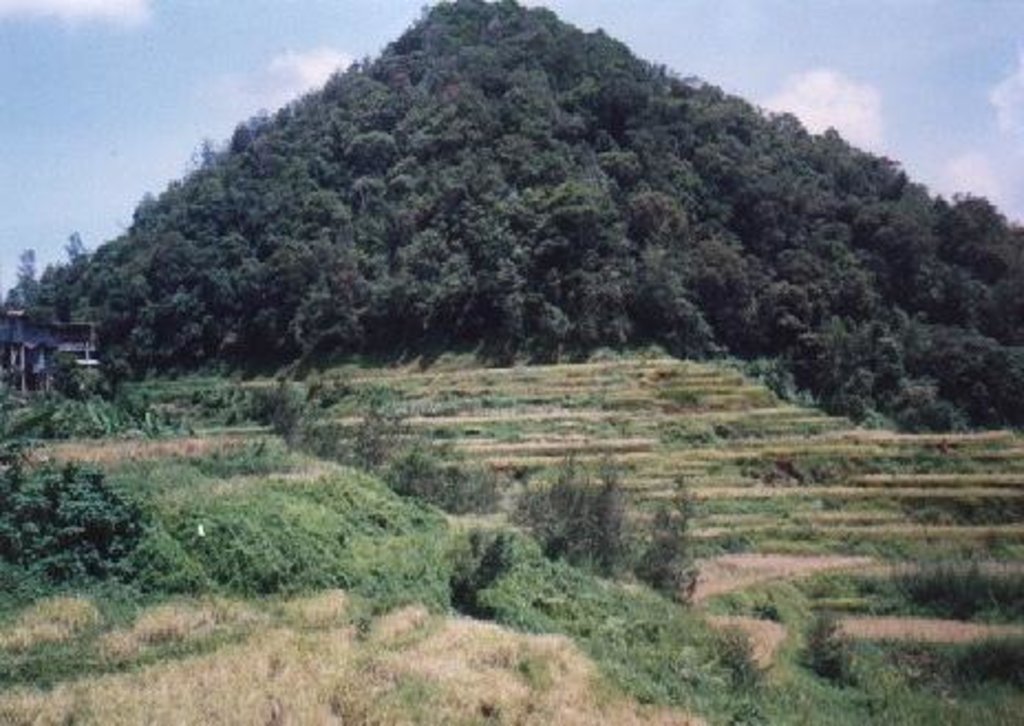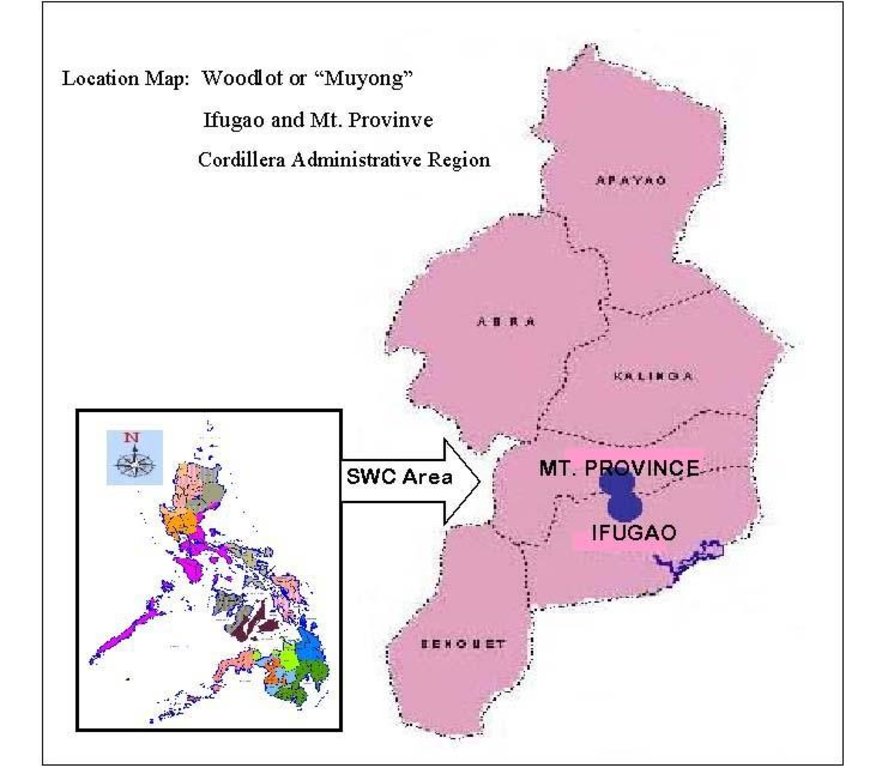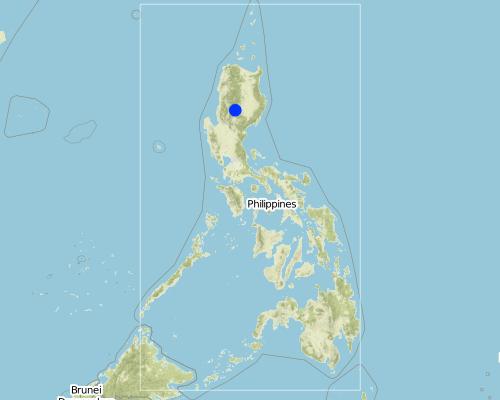Woodlot [الفيليبين]
- تاريخ الإنشاء:
- تحديث:
- جامع المعلومات: Unknown User
- المحرر: Deborah Niggli
- المُراجع: Deborah Niggli
Muyong
approaches_1955 - الفيليبين
عرض الأقسام
توسيع الكل طي الكل1. معلومات عامة
1.2 تفاصيل الاتصال بالأشخاص الرئيسيين لمصدر المعلومات والمؤسسات المعنية بتقييم وتوثيق النهج
اسم المشروع الذي سهّل توثيق/تقييم النهج (إذا كان ذلك على صلة)
Decision Support for Mainstreaming and Scaling out Sustainable Land Management (GEF-FAO / DS-SLM)1.3 الشروط المتعلقة باستخدام البيانات الموثقة من خلال WOCAT
متى تم تجميع البيانات (ميدانيا)؟:
15/01/2009
يوافق جامع المعلومات والشخص (لاشخاص) الرئيسي لمصدر المعلومات على الشروط المتعلقة باستخدام البيانات الموثقة من خلال WOCAT:
نعم
2. وصف نهج الإدارة المستدامة للأراضي
2.1 وصف موجز للنهج
Woodlot is a forest management approach which aims the to provide food, wood for fule, construction and material for woodcarving and to provide a steady source of water for the lower-hilly riceland area.
2.2 وصف تفصيلي للنهج
وصف تفصيلي للنهج:
Woodlot or 'muyong' as it is called in the local language is basically a timber management system. The harvesting of non-timber products like fruits and other benefits like the maintenance of a stable water supply are secondary objectives. Fuelwood and construction timber are the major products of woodlot. The usual size of woodlot is not more than one hectare and is individually owned. The approach is believed to have started at least a century ago. It began when it became apparent that sources of fuelwood near homes were becoming difficult to find. The approach also came about when people realized the need for accountability in the use and management of natural resources. The ancestors of the present-day owner of the woodlots were influenced by the relationship of a reliable and steady water supply and the existence of forest. Woodlots normally evolved from swidden fields. The owners encouraged the growth of prefered species either by direct seeding or by transplanting seedlings uprooted fron nearby forest.
Present practices involve the growing of introduced-fast growing species such as mahogany (Switeria macrophylla) and gmelina (Gmelina arborea). Rattan a valuable material for the furniture industry is also raised in the woodlot. Medicinal herbs are also gathered. Mushrooms and nuts are also grown. Woodlot is an approach unique to the indigenous tribes of the Cordillera. Boundaries, tenures and disputes are settled based on local traditions and beliefs. Common disputes arise from illegal gathering of fruit products. Transfer of ownership is upon the discretion of parents and only to married children. Inheritance of a woodlot denotes the handling down of authority and responsibility over the family. Woodlot or 'muyong'has been hailed as one of the nine successful 'Traditional Forest Related Knowledge' (TFRK). In terms of sophistication and social organization, woodlot is no equal among the approaches being practiced by the different ethnic groups in the country.
2.3 صور عن النهج
2.5 البلد/المنطقة/المواقع التي تم تطبيق النهج فيها
البلد:
الفيليبين
المنطقة/الولاية/المحافظة:
Mountain Province and Ifugao
Map
×2.6 تواريخ بدء وإنهاء تنفيذ النهج
في حالة عدم معرفة السنة بالتحديد، يرجى الإشارة إلى التاريخ التقريبي لبدء النهج:
منذ أكثر من 50 عامًا (تقليدي)
2.7 نوع النهج
- تقليدي/أصلي
2.8 الغايات/الأهداف الرئيسية للنهج
Sustainable use of forest resources by employing traditional beliefs, customs and traditions. Promote ecological balance.
2.9 الظروف التي تمكن أو تعيق تنفيذ التقنية/التقنيات المطبقة بموجب النهج
الإطار القانوني (حيازة الأراضي، وحقوق استخدام الأراضي والمياه)
- تمكين/تمكيني
Regalian doctrine which says that all public lands are owned by the state. -> Regular maintenance of a portion of the forest by weeding, removing of vines and undesirable species.
المعرفة حول الإدارة المستدامة للأراضي، والوصول إلى الدعم الفني
- تمكين/تمكيني
Lack of knowledge on the proper care and maintenance of forest resources. -> Provisions of traditional skills, customs and beliefs in the care and maintenance.
3. المشاركة وأدوار الأطراف المعنية
3.1 أصحاب المصلحة المعنيون بالنهج وأدوارهم
- مستخدمو الأراضي المحليون/المجتمعات المحلية
Specific ethnic groups: The indigenous tribes in the Cordillera and Caraballo mountain ranges in Northern Luzon.
3.2 انخراط مستخدمي الأراضي المحليين/المجتمعات المحلية في المراحل المختلفة للنهج
| انخراط مستخدمي الأراضي المحليين/المجتمعات المحلية | حدد من شارك وصف الأنشطة | |
|---|---|---|
| المبادرة/التحفيز | سلبي | |
| التخطيط | سلبي | |
| التنفيذ | سلبي | |
| الرصد/التقييم | غير موجود |
3.4 اتخاذ القرار بشأن اختيار تقنية/تقنيات الإدارة المستدامة للأراضي
حدد من الذي قرر اختيار التقنية/التقنيات التي سيتم تنفيذها:
- مستخدمو الأراضي وحدهم (المبادرة الذاتية)
اشرح:
Land user driven (bottom-up). Indigenous practice. Consultation among clan members and between clan.
حدد على أي أساس تم اتخاذ القرارات:
- خبرة وآراء شخصية(غير موثقة)
4. الدعم الفني وبناء القدرات وإدارة المعرفة
4.1 بناء القدرات/التدريب
هل تم تقديم التدريب لمستخدمي الأراضي / الأطراف المعنيين الآخرين؟:
نعم
حدد من تم تدريبه:
- مستخدمو الأراضي
شكل التدريب:
- في العمل
المواضيع المغطاة:
Informal training among family members on the management of forest for sustainable use.
4.2 خدمة استشارية
هل يملك مستخدمو الأراضي وصولا إلى خدمة استشارية؟:
نعم
حدد ما إذا كانت الخدمة الاستشارية متوفرة:
- في حقول مستخدمي الأراضي
وصف/تعليقات:
Environmental protection particularly watershed management is a top priority of the government and NGO's. The 'woodlot' approach of watershed protection is regarded as a perfect example of forest management being employed by indigenous people.
4.3 تعزيز المؤسسات (التطوير التنظيمي)
هل تم إنشاء أو تعزيز مؤسسات من خلال هذا النهج؟:
- نعم، باعتدال
حدد المستوى (المستويات) التي تم فيها تعزيز أو إنشاء المؤسسات:
- محلي
صف المؤسسة والأدوار والمسؤوليات والأعضاء وما إلى ذلك.
by promoting aesthetics
4.4 الرصد والتقييم
هل يشكل الرصد والتقييم جزءا من النهج؟:
نعم
إذا كانت الإجابة بنعم، فهل من المقصود استخدام هذه الوثائق للمراقبة والتقييم؟:
كلا
4.5 البحوث
هل كانت البحوث جزءًا من النهج؟:
نعم
حدد المواضيع:
- علم الاجتماع
- الاقتصاد / التسويق
- علم الايكولوجيا
- تكنولوجيا
أعط تفاصيل إضافية وأشر إلى من قام بالبحوث:
Researches on traditional forest knowledge of different ethnic groups.
5. التمويل والدعم المادي الخارجي
5.1 الميزانية السنوية لمكون الإدارة المستدامة للأراضي في النهج المذكور
التعليقات (على سبيل المثال المصادر الرئيسية للتمويل/الجهات المانحة الرئيسية):
land users 100%
5.2 الدعم المالي/المادي المقدم لمستخدمي الأراضي
هل حصل مستخدمو الأراضي على دعم مالي/ مادي لتنفيذ التقنية/ التقنيات؟:
نعم
5.3 إعانات لمدخلات محددة (بما في ذلك العمالة)
- معدات
| حدد المدخلات التي تم دعمها | إلى أي مدى | حدد الإعانات |
|---|---|---|
| أدوات | ||
- زراعة
| حدد المدخلات التي تم دعمها | إلى أي مدى | حدد الإعانات |
|---|---|---|
| بذور | ||
| seedlings | ||
إذا كان العمل من قبل مستخدمي الأراضي مدخلاً جوهريًا، فهل كان:
- تطوعي
5.4 الائتمان
هل تم توفير ائتمان في إطار نهج أنشطة الإدارة المستدامة للأراضي؟:
كلا
5.5 حوافز أو وسائل أخرى
هل تم استخدام حوافز أو أدوات أخرى لتشجيع تنفيذ تقنيات الإدارة المستدامة للأراضي؟:
كلا
6. تحليل الأثر والتصريحات الختامية
6.1 آثار النهج
هل نجح النهج في تعبئة/تحسين الوصول إلى الموارد المالية لتنفيذ الإدارة المستدامة للأراضي؟:
- لا
- نعم، قليلا
- نعم، باعتدال
- نعم، إلى حد كبير
The approach contributed to effective water conservation to sustain the rice terraces
هل أدى النهج إلى تحسن في مسائل حيازة الأراضي / حقوق المستخدمين التي أعاقت تنفيذ تقنيات الإدارة المستدامة للأراضي؟:
- لا
- نعم، قليلا
- نعم، باعتدال
- نعم، إلى حد كبير
The land use right (no land titles) is being respected and honored and the approach fits well in the over-all scheme. The land use right is well respected in the communities. Conflicts are peacefully resolve through compromises and agreements.
Did other land users / projects adopt the Approach?
- لا
- نعم، قليلا
- نعم، باعتدال
- نعم، إلى حد كبير
The concept is being adopted in other areas with different degrees of success. It is being talked about as a classic example of resource management.
6.3 استدامة أنشطة النهج
هل يمكن لمستخدمي الأراضي المحافظة على استدامة ما تم تنفيذه من خلال النهج (بدون دعم خارجي)؟:
- نعم
6.4 نقاط قوة/مزايا النهج
| نقاط القوة/ المزايا/ الفرص من وجهة نظر مستخدمي الأراضي |
|---|
| Strong respect for customs/traditions in the management of resources. |
| Strong backing from local government units (LGU's) |
| نقاط القوة/ المزايا/ الفرص من وجهة نظر جامع المعلومات أو غيره من الاشخاص الرئيسيين لمصدر المعلومات |
|---|
| Respect for land users rights even though there is no legal documents to hold on for the land |
| Continous replanting |
| Strong resolve of the land users on the need for sustainability. |
6.5 نقاط الضعف/ العيوب في المنهج وطرق التغلب عليها
| نقاط الضعف/ المساوىء/ المخاطر من وجهة نظر مستخدم الأراضي | كيف يمكن التغلب عليها؟ |
|---|---|
| Woodlot can be a sanctuary for pests for the nearby rice fields. | Maintenance and cleanliness. |
| نقاط الضعف/ المساوىء/ المخاطر من وجهة نظر جامع المعلومات أو غيره من الاشخاص الرئيسيين لمصدر المعلومات | كيف يمكن التغلب عليها؟ |
|---|---|
| Not all members of the community is involved/benefited. | Wider involvement using other areas within the vicinity of the community. |
| Tendency for the woodlot to be commercialized and over-exploited. | Carrying capacity of the woodlot should be determined. |
7. المراجع والروابط
7.1 طرق جمع/مصادر المعلومات
- زيارات ميدانية، مسوحات ميدانية
- مقابلات مع مستخدمي الأراضي
7.2 المراجع للمنشورات المتاحة
العنوان، المؤلف، السنة، النظام القياسي الدولي لترقيم الكتب ISBN:
Report on the Study of Traditional Forest Related Knowledge of the Ifugao and Bontoc Ethnic Groups in the Cordillera Region of the Philippines
متاح من أين؟كم التكلفة؟:
Department of Environment and Natural Resources, Quezon City
العنوان، المؤلف، السنة، النظام القياسي الدولي لترقيم الكتب ISBN:
Environmental and Socio-Economic Impact, Analysis of an Indigenous and Introduced Agroforestry Systems in Luzon.
متاح من أين؟كم التكلفة؟:
University of the Philippines Los Banos Library, Los Banos, Laguna
الروابط والوحدات المواضيعية
توسيع الكل طي الكلالروابط
لا يوجد روابط
الوحدات المواضيعية
لا يوجد وحدات مواضيعية


